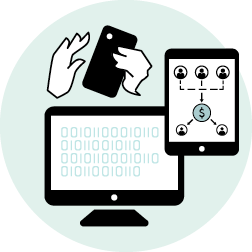Do you remember the first few times you swiped your credit or debit card to make a purchase? And how often you swiped too fast, too slow, or with the wrong side of the card?
How about the first time you used a chip card and inserted it the wrong way into the card reader? And continued to dip it the wrong way on other occasions because you just weren’t paying attention?
Welcome to the state of contactless card payments in the U.S. today: we’re making many more contactless transactions, but we’re also on a bit of a learning curve.
However, given the speed, ease, security, and perceived health benefits of contactless payments, their use will continue to rise, experts say. Merchants who aren’t prepared for them are going to want to be, and very soon.
How Contactless Cards Work
Contactless cards use radio-frequency identification (RFID) technology that allows the card to communicate with the card reader via antenna when the card is held near the reader during a transaction. You have to be within close proximity – roughly 3 inches – to the contactless-enabled credit card terminal for the radio antenna to pick up your card’s signal. It is often referred to as tap-to-pay, but tapping is not needed, just close proximity.
Contactless cards also come with an EMV chip and the usual credit or debit card number, expiration date, security code and magnetic stripe. If a store doesn’t have contactless readers, you can still swipe your card or use the chip reader.
Just as our first tries at swiping and dipping cards could be frustrating, finding the sweet spot on any given terminal for a contactless transaction can be tricky. But once you get the hang of it, you’ll find that the transactions are fast – fast enough to keep checkout lines moving and improve the shopping experience.
Health Concerns Drive Adoption in the U.S.
The U.K., European Union, Canada, and Australia were early adopters of contactless technology. Many markets outside the U.S. saw contactless usage go from single digits to over 50% usage within 18 to 24 months, PYMTS.com reported in 2018. In contrast, before 2020 the U.S. was relatively slow to adopt contactless payment methods. In 2018, A.T. Kearney reported that less than 1% of point-of-sale transactions were contactless.
While Americans have much more rapidly adopted other forms of contactless transactions such as ordering online or buying through apps, this past year accelerated the need for businesses to offer capabilities like tap-to-pay at terminals.
With much initial attention focused on the potential to transmit COVID-19 through touch, many businesses and cardholders joined the trend toward contactless payments. 31 million Americans used a Visa contactless card (or digital wallet) in March 2020 – up from 25 million in November 2019, Wirecutter, a New York Times-produced newsletter, reported. Overall use of contactless payments in the U.S. has grown 150% since March 2019.
Security misconceptions also have been a major obstacle for contactless payment growth in the U.S. Consumers are concerned about fraudsters being able to steal personal information during the transmission of payment information.
While no credit or debit card is entirely safe, contactless cards are equipped with safeguards such as chip encryption to protect sensitive information from malicious attacks, according to an article on creditcards.com, a website that helps consumers find credit cards that fit their needs. Only information of extremely limited value can be “stolen” from a contactless card. (The article debunks other contactless credit card myths.)
Contactless Payment Offers Competitive Advantage to SMEs
The pandemic drove countless changes in habit and behavior, and many of them will remain, at least in part. As companies reopen, for example, very few expect 100% of office workers to be in their cubicles 100% of the time. Contactless card payments appear to be another genie that’s not going back in the bottle. According to a recent study by Visa, 65% of consumers would prefer to use contactless payments as much as, or more than, they are currently.
However, while contactless transactions are way up, non-contact forms of payment have been adopted mostly by large companies, Security Intelligence says. The move to contactless payments has been slower for small and mid-size enterprises (SMEs). As of early 2021, Visa reported that 39% of SMEs accept some form of contactless payment, while overall, 67% of businesses have implemented contactless payment, according to Forrester.
Why might adoption among smaller businesses be slow? The technology lag common among small and mid-sized businesses might be to blame. New technology requires money and time to implement – two resources SMEs sometimes find themselves short of.
In addition, infrastructure may stand in the way. Nearly all new payment terminals come contactless-capable, meaning they have the hardware they need for contactless payments, PYMNTS.com says. But merchants with older systems need to upgrade them with new hardware and software to meet requirements. And even with new terminals, the software to enable them must be activated.
Contactless cards are available from most issuers and many consumers are ready and willing to use them. Their numbers will only increase. Contactless payment could offer a small or medium-size business a competitive advantage. Adoption sooner rather than later is the wise move -- until the next new payment option comes along and we’re all back on another learning curve.
To learn more about MerchantE's contactless payment options, call 1-866-504-1055 or get more information here!




